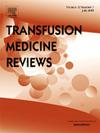Single vs Double-Unit Transfusion in Patients With Hematological Disorders Undergoing Chemotherapy or Stem Cell Transplantation: A Systematic Review And Meta-Analysis
IF 2.5
2区 医学
Q2 HEMATOLOGY
引用次数: 0
Abstract
There is no consensus to support the single unit-transfusion policy (1-RBC) over the double-unit transfusion policy (2-RBC) in patients with hematological disorders undergoing chemotherapy or stem cell transplantation. We searched PubMed, Embase, and Cochrane Library. Risk ratios (RR) and mean differences (MD) were pooled. Statistical analysis was performed using Review Manager and R software. Heterogeneity was assessed using I2 statistics. Hemoglobin (Hb) levels at discharge (MD −0.41 g/dL; 95% CI −0.53, −0.29 g/dL; P < .01) and total RBC units used per admission (MD −0.82 units; 95% CI −1.60, -0.05 units; P = .04) were significantly lower in patients who received 1-RBC, while length of hospital stay (MD 0.05 days; 95% CI −0.29, 0.39 days; P = .89), severe bleeding (RR 1.52; 95% CI 0.85, 2.71; P = .16) and mortality (RR 0.89; 95% CI 0.52, 1.53; P = .69) showed no significant difference between groups. In patients with hematological disorders undergoing chemotherapy or stem cell transplantation, 1-RBC is associated with lower Hb levels at discharge and a reduction in the total number of RBC units used per admission, with no significant difference in terms of length of hospital stay, severe bleeding risk, transfusion-related adverse events and mortality.
接受化疗或干细胞移植的血液病患者的单单位输血与双单位输血:系统综述与元分析》。
对于接受化疗或干细胞移植的血液病患者,目前尚无共识支持单单位输血政策(1-RBC)而非双单位输血政策(2-RBC)。我们检索了 PubMed、Embase 和 Cochrane 图书馆。对风险比(RR)和平均差(MD)进行了汇总。使用Review Manager和R软件进行统计分析。异质性采用I2统计量进行评估。接受 1-RBC 治疗的患者出院时的血红蛋白 (Hb) 水平(MD -0.41 g/dL; 95% CI -0.53, -0.29 g/dL; P < .01)和每次入院使用的 RBC 总单位(MD -0.82 单位; 95% CI -1.60, -0.05 单位; P = .04)显著降低,而住院时间(MD 0.05天;95% CI -0.29,0.39天;P = .89)、严重出血(RR 1.52;95% CI 0.85,2.71;P = .16)和死亡率(RR 0.89;95% CI 0.52,1.53;P = .69)在组间无显著差异。在接受化疗或干细胞移植的血液病患者中,1-RBC 与出院时较低的 Hb 水平和减少每次入院使用的 RBC 单位总数有关,但在住院时间、严重出血风险、输血相关不良事件和死亡率方面无明显差异。
本文章由计算机程序翻译,如有差异,请以英文原文为准。
求助全文
约1分钟内获得全文
求助全文
来源期刊

Transfusion Medicine Reviews
医学-血液学
CiteScore
11.60
自引率
0.00%
发文量
40
审稿时长
21 days
期刊介绍:
Transfusion Medicine Reviews provides an international forum in English for the publication of scholarly work devoted to the various sub-disciplines that comprise Transfusion Medicine including hemostasis and thrombosis and cellular therapies. The scope of the journal encompasses basic science, practical aspects, laboratory developments, clinical indications, and adverse effects.
 求助内容:
求助内容: 应助结果提醒方式:
应助结果提醒方式:


